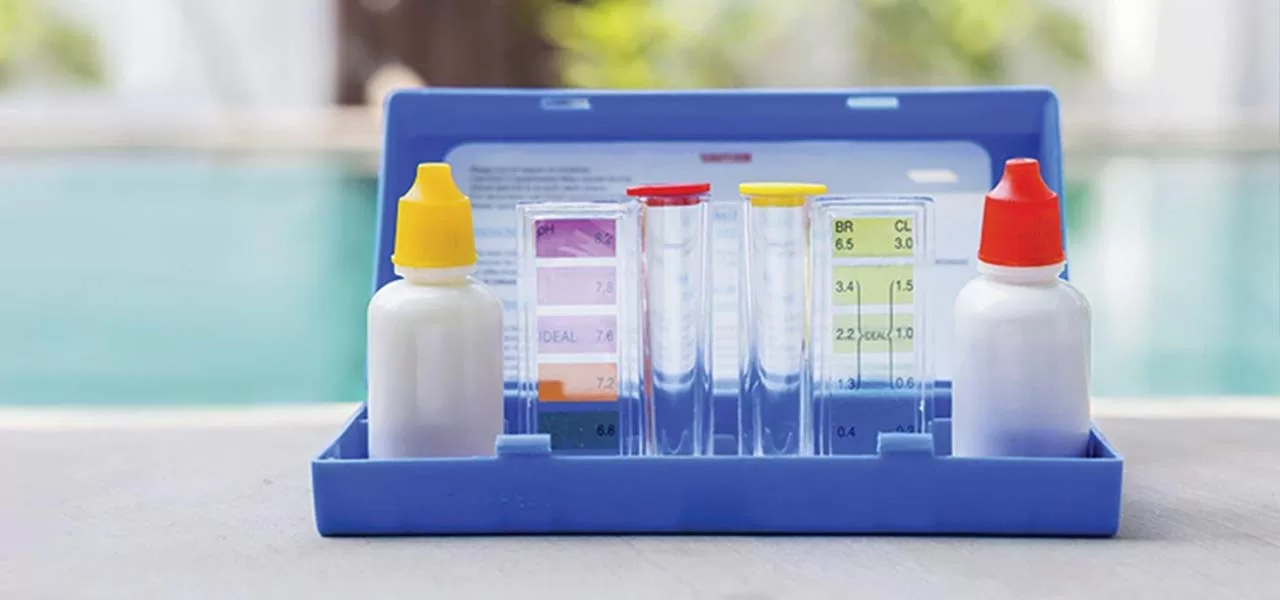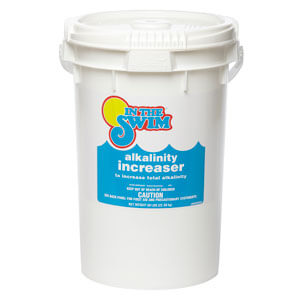FREE Standard Shipping On All Orders $100 or More!*

Pool pH & Alkalinity: Tips & Troubleshooting
Pool pH and Total Alkalinity are crucial for protecting pool surfaces and providing sanitary water conditions. However, they can be challenging to manage unless you understand what they are and their role in overall pool balance. In this post, we'll go over exactly what pH and Total Alkalinity are, why they're important for the health of your pool, the impact of high or low pH/Total Alkalinity, and how to address tough issues that might arise from an imbalance. Class is now in session – let's dive in!
What is pH?

The pH balance in your swimming pool is arguably the single most important factor in maintaining clear, comfortable water. It is a measurement of how acidic or basic the water is, and is based on a scale from 0-14, with a pH reading of 7 being neutral. Anything below 7 is considered acidic, while anything above 7 is considered basic or alkaline. For swimming pools, the ideal pH range is 7.4-7.6 (7.2-7.8 acceptable).
A proper pH reading will keep swimmers’ skin and eyes comfortable, and protects pool surfaces against corrosive damage, stains and scale buildup. Balanced pH allows chlorine to do its job most effectively, keeping your pool clean, clear, and algae-free. As a general rule of thumb, pH can be adjusted with the following:
- 1 oz. of pH Increaser (soda ash or sodium carbonate) added to 1,000 gallons will raise pH by 0.1.
- 1 oz. of pH Reducer (sodium bisulfate) added to 1,000 gallons will lower pH by 0.1.
When balancing pH, always consult the product label for guidelines and instructions. It can be easy to miss the mark when adjusting pool pH, as pH adjustment can be affected by the temperature, Total Alkalinity, and Calcium Hardness levels of your water. Try not to overdose the pool, and always test pH level a few hours after adding pH chemicals to confirm that you've restored proper balance.
What is Total Alkalinity?
Total Alkalinity is very closely related to pH, as it is a measurement of all alkaline substances in the water. Proper Alkalinity levels are a key factor in maintaining pH – many describe it as being a “pH buffer.” Low Total Alkalinity levels causes rapid pH fluctuations, and high levels make pH difficult to adjust. That said, it's best to adjust one and then the other, not both at the same time. If Total Alkalinity is out of balance, address it first.

The best range for Total Alkalinity depends which sanitizer you use. If using calcium hypochlorite (cal-hypo), sodium hypochlorite, or lithium hypochlorite as your primary sanitizer, the ideal TA range is 80-100 ppm. When using dichlor, trichlor, or bromine as your primary sanitizer, the ideal range is between 100-120 ppm. For a salt water chlorine generator, most manufacturers recommend TA levels between 80-120 ppm. Maintaining the right balance of pH and Total Alkalinity is essential to keeping your pool water in good condition.
If your Total Alkalinity levels are too low (below 80 ppm) but pH levels are above 6.8, you will need to add Alkalinity Increaser (sodium bicarbonate). When both Total Alkalinity and pH are too low (TA less than 80 ppm, pH below 6.8), use pH Increaser (sodium carbonate) to bring both levels up. If your Total Alkalinity levels are too high, add pH Reducer (sodium bisulfate).
Lowering Total Alkalinity levels can be a lengthy, sometimes frustrating process, as sodium bisulfate will also have the effect of reducing your pH at the same time as it lowers your Total Alkalinity. You may need to make repeated adjustments of lowering Alkalinity and then raising pH until both come into proper range. No matter what adjustments you need to make, always retest the water with test strips or a test kit before adding more chemicals. Again, always follow dosing and application instructions from the product label as you move levels gradually into the proper range.
Why Are pH and Total Alkalinity Important for My Pool?
Unbalanced pH and Total Alkalinity can quickly throw your whole pool into a downward spiral, costing you loads of time and money on cleaning, repairs, and extra chemicals.
Low pH in Pools
- Etching and erosion of grout and plaster
- Vinyl liners become stiff and brittle
- Solar covers and pool floats are damaged
- Corrosion and oxidation of metals on ladders, lights, and heat exchangers
- Plastic fittings (returns, skimmer faceplates) become brittle
- Swimmer comfort issues, including burning eyes and dry skin
- Free Available Chlorine dissipates faster than normal
High pH in Pools
- Chlorine is around 50% less effective at pH levels over 8.2
- Scaling from calcium deposits on pool surfaces and waterline
- Algae blooms likely
- Pool water may appear cloudy and dull
Low Total Alkalinity in Pools
- Etching of pool plaster
- Vinyl liners become stiff and brittle
- Corrosion of metals in ladders, handrails, and heat exchangers
- Swimmer comfort issues, including burning eyes and dry skin
- Pool surface stains
- Rapid fluctuations in pH, known as “pH bounce”
High Total Alkalinity in Pools
- Decreased chlorine effectiveness
- Frequent problems with cloudy water
- Stain and scale formation on pool surfaces
- Difficulty adjusting pH level – pH increases despite regular addition of pH reducer

Common Problems with Pool pH and Total Alkalinity
Now that you have a basic understanding of how Total Alkalinity and pH work together, let's take a closer look at how to resolve specific balance issues in your pool. We've said it before, but we'll say it again – when making any adjustments to your water's chemistry, ALWAYS read and follow product label instructions, and only add balancing chemicals to the pool if the pump is running. Start with an accurate pool water test to ensure you're dosing the pool correctly. And remember: it's far better to make small, gradual adjustments than it is to make large changes. Keep on top of pool water chemistry with regular testing 2-3 times per week.
Pool pH is Always High
The most common reason for a consistently high pH level in pools is the use of liquid chlorine or a saltwater system as the primary sanitizer. Sodium hydroxide is produced, which has a pH of around 13. New pool plaster or pebble finishes will also raise pH in pools for about a year after installation. If your pool has water features, such as a waterfall or fountain, these will also raise pH levels in your pool (more on that below).
Pool pH is Always Low
The most common cause of a consistently low pH level in pools is using chlorine tablets or stabilized forms of chlorine. These have a pH level of around 3. Acidic rainfall, heavy leaf debris, and dirt/mulch in the pool can also lower the pH level.
Pool pH is Low, Total Alkalinity is High
High Total Alkalinity over 180 ppm can cause some resistance to pH change. Adding pH Increaser can also raise Total Alkalinity, compounding the problem. Make repeated adjustments of lowering Alkalinity and then raising pH until both come into proper range, testing the water each time before adding more chemicals.
Pool pH is High, Total Alkalinity is Low
Low Total Alkalinity under 80 ppm can cause pH to be unstable and erratic. To raise it, add Alkalinity Increaser (add 1 lb. per 10,000 gals to increase by 10 ppm). Keep in mind that this will also slightly raise your pool's pH level, but not as much as the Total Alkalinity level. Once TA is back in balance, you can adjust pH. Just like in the scenario above, you may need to make repeated alternating adjustments to get the levels just right.
Pool pH and Total Alkalinity are Both High
To lower both pH and Total Alkalinity you only need pH Reducer, otherwise known as dry acid. Muriatic acid, Acid Magic, and No Mor Acid can also be used to lower Total Alkalinity and pH levels in pools.
Pool pH and Total Alkalinity are Both Low
To raise pH and Total Alkalinity at the same time, use pH Increaser. Be sure to test for the presence of metals first, and address those issues before adding product to the pool.
Pool pH will not Increase or Decrease
If it seems like you keep adding pH Increaser or pH Reducer, but it only seems to last a day (if it even has effect at all), high Total Alkalinity levels over 180 ppm may be preventing you from making an effective adjustment. For pools with high Total Alkalinity and high pH levels, add pH Reducer or other acid to affect both.
Is it Safe to Swim in High or Low pH or Alkalinity?
Maybe yes, maybe no. Your pool water pH and Total Alkalinity can affect disinfection by chlorine. Chlorine is very slow to react at high pH levels, and can dissipate quickly at low pH levels. However, a pool could still be sanitary with good levels of Free Available Chlorine and effective filtration. However, the water may be uncomfortable for the skin and eyes, and will damage your pool over time. It's important to address chemical imbalances as quickly as possible to keep your pool experience pleasant.
Bonus Tips

Use Aeration to Raise Pool pH
Looking to raise pH without affecting Total Alkalinity? You can sometimes raise the pH through aerating the pool water. Yep, just add air! It's the same reason hot tubs and spas often suffer from high pH issues. Although this will raise your pH, it's important to note that this isn't an exact science, and results will vary by pool.
You can aerate a pool by bubbling air through the water, agitating the surface, spraying droplets through the air with a pool fountain, or even just playing and splashing around in the pool. During the hot summer months, this method also can be used to lower pool water temperature.
Getting an Accurate Water Test
One more tip! For correct pH and Total Alkalinity testing, a titration test is generally much more accurate than test strips. We like to recommend the Taylor K-2005, but if the price tag is too much, take a look at the less expensive Swimline 4-in-1 for a reliable pool pH and Alkalinity test kit.
If you have any other questions about pool pH or Total Alkalinity chemicals that we didn't cover, let us know. You can also check out our handy dosage charts for more information about how to reach specific levels with water balancing chemicals.